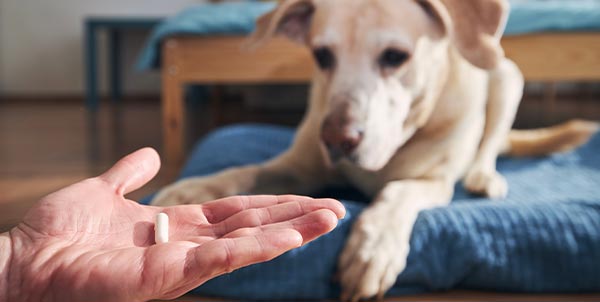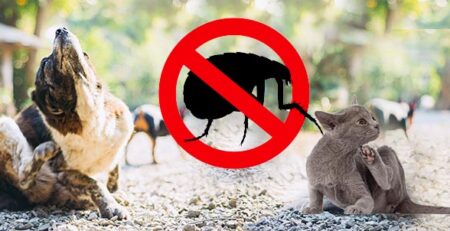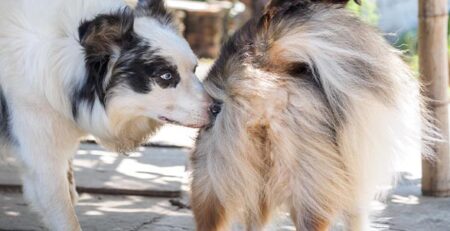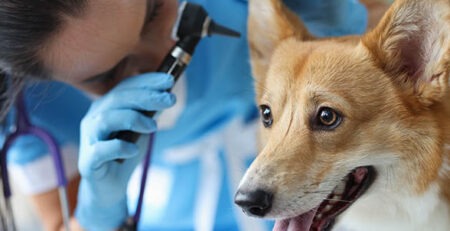Table of Contents
If your adult or older dog tends to put on weight, is lazy and cold, maybe it’s not all the fault of old age but may be suffering from hypothyroidism.
So, if you want to get him back in shape, make him spry again, and ensure his long life, know that there is a simple and effective cure, and we explain what it consists of.
Hypothyroidism is one of the most common metabolic diseases that mainly affects adult and older dogs and consists of a loss of function of the thyroid gland, an endocrine gland located around the trachea and below the larynx.
Medical treatment offers an excellent chance of success, yet because hypothyroidism has clinical signs typical of other diseases, it is often underdiagnosed.
Do you know the difference between hypothyroidism and hyperthyroidism?
The
thyroid
is stimulated by the brain to produce
two hormones
main ones: T4 (L-Tyroxine) and T3 (L-Tetraiodothyronine), released under the stimulation of another hormone (TSH) produced in turn by thepituitary gland.
The thyroid gland can be affected by numerous diseases that impair its function, resulting in lower (hypothyroidism) or higher (hyperthyroidism) production of secreted hormones.
Hypothyroidism is common in dogs but very rare in cats, which, instead, more frequently develop hyperthyroidism.
Complicating the picture is sometimes the difficulty in interpreting the diagnostic tests performed, because they are often influenced in their results by other diseases or medications taken.
Do you know what thyroid hormones are used for?
Thyroid hormones have many functions in the body.
They mainly support the metabolic activity of many tissues in the body and increase oxygen consumption.
Thyroid hormones are also considered growth factors:
- regulate metabolism
- They stimulate protein synthesis
- promote growth and mineralization of the skeletal system
Did you know that hypothyroidism can be either congenital or acquired?
Hypothyroidism can be acquired or congenital: in almost all cases it arises in adult animals.
The average age of onset of acquired hypothyroidism is 7 years.
It rarely occurs in young subjects and is congenital in origin.
What forms of hypothyroidism exist in dogs and cats?
Acquired hypothyroidism is distinguished into primary, secondary and tertiary based on the location of the disorder.
Primary hypothyroidism occurs when the thyroid gland is affected by a disease process that impairs its function; in this case, the most common forms are lymphocytic thyroiditis and thyroid atrophy.
The very rare forms of secondary hypothyroidism involve the pituitary gland and are characterized by TSH deficiency.
Tertiary ones, which instead involve the hypothalamus and TRH hormone release, are even rarer.
What main symptoms can be attributed to hypothyroidism?
Because thyroid hormones are involved in the metabolism of almost all functions of the body, a deficiency in thyroid hormones induces a nonspecific clinical picture, common to many other diseases, with inconspicuous and progressive symptoms that are often mistaken for normal signs of aging.
In adult dogs, the most frequent clinical signs are:
– lethargy
– mental dulling
– Weight gain (with reduced or normal appetite)
– intolerance to exercise and cold
Young individuals with congenital hypothyroidism, on the other hand, because skeletal development is slowed by the reduced ability to synthesize hormones, may exhibit symptoms of dwarfism.
Skin abnormalities may also be symptoms of the disease
The skin of hypothyroid dogs is predisposed toward bacterial infections and also has skin abnormalities such as alopecia and seborrhea: the skin appears scaly but without signs of itching or irritation.
Fur loss usually affects the trunk, hind legs, and tail.
Other changes that can be observed, although less frequent, are neurological disorders, ocular and cardiovascular changes.
How is hypothyroidism diagnosed?
The most frequently observed changes in blood tests of hypothyroid dogs are mild anemia, a variable degree increase in cholesterol and triglycerides.
However, these changes are nonspecific, and additional tests quantifying hormones in the blood are necessary to confirm the diagnosis.
The typical picture of a dog with primary hypothyroidism is characterized by lower than normal T4 and higher TSH values.
How do you treat an animal with hypothyroidism?
Treatment in dogs with hypothyroidism is aimed at restoring T3 and T4 levels through the administration of synthetic hormones, the dosage of which will be indicated to you by your trusted veterinarian.
The best indicator of successful treatment of hypothyroid dogs is resolution of clinical symptoms and changes observed in blood tests, as well as normalization of thyroid hormones.
Monitoring hypothyroid dogs involves periodic visits to the veterinarian.
Initially, checkups should be done every 2-4 weeks, or as needed.
Thereafter, if the hypothyroid dog is clinically stable, checkups are to be done every 4-6 months.
Can hypothyroidism be cured?
Unfortunately, to date there is no cure that leads to restoration of gland function, but in most hypothyroid dogs the prognosis is good if therapy is administered correctly and for life.
In contrast, the prognosis may be poor in untreated hypothyroid dogs if the diagnosis is late.
Dogs untreated for a long time that arrive at the veterinarian in a severely lethargic condition, with reduced body temperature and heart rate, may go into a coma and die.
Is there a race predisposition?
Hypothyroidism affects all dog breeds, but some are more prone to develop it:
- Golden Retriever
- Doberman
- Labrador
- Cocker Spaniel
- English and Irish setter
- Rhodesian
- Boxer
- Dachshund
- Great Dane
- Beagle
- Borzoi
- Poodle
- Schnauzers
To detect the onset of this and other diseases early, it is important that you have your adult or senior dog, at least two annual checkups.
Remember that at La Veterinaria Clinic you can book the preventive diagnostic check-up to assess the health status of your dog or cat and perform in-house to the specific examinations needed.
Clinica La Veterinaria is always open h24 every day including holidays and with First Aid service from 8 pm to 8 am.
For the joy of seeing them HAPPY.











